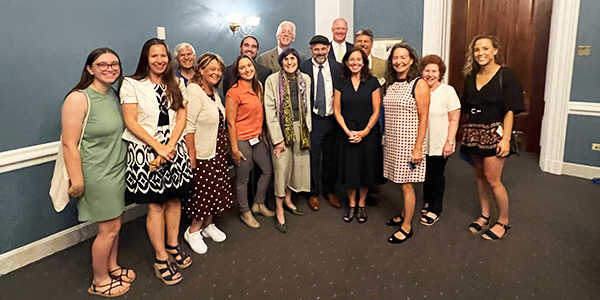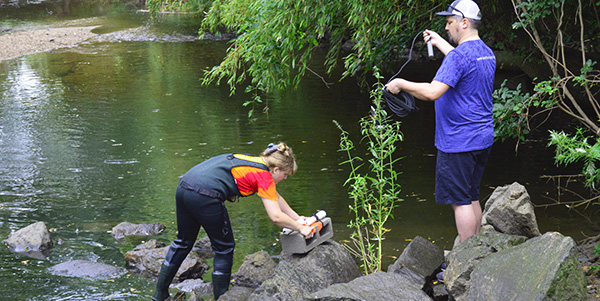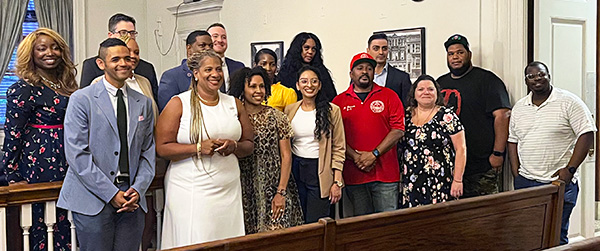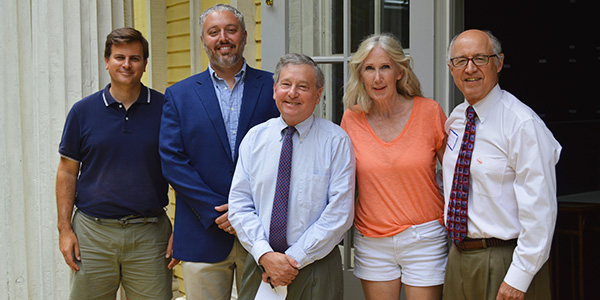Soundkeeper Team Hits the Road
Soundkeeper headed to the U.S. Capitol
Long Island Soundkeeper Bill Lucey and other representatives from the Long Island Sound Study Citizens Advisory Committee went to Washington, D.C. recently with a big ask: an increase of federal funding for the Sound to $40 million. They came armed with stories of how past money has benefitted fish and wildlife, created jobs, and boosted the economy.
“I talked to several anglers, who told me this is the best striped bass fishing they’ve seen in the last 15 years,” said Bill. “Menhaden are now so abundant, it’s brought whales and porpoises and seals into Long Island Sound. Sharks are showing up. There’s plenty of protein for bald eagles and osprey.”
They talked about the 6,000 acres of shellfish beds that have reopened off Long Island’s Hempstead Harbor, Glen Cove, and Oyster Bay (after being closed since 1972!), the $1 million generated for the economy, and the new generation entering the shellfish aquaculture industry.
“As the water increases in temperature,” said Bill, “we can start backsliding on the gains we’ve made. We need to increase the funding to full authorization.”

Soundkeeper Associate headed to the North Fork
Two days after Bill returned from D.C., Emma DeLoughry made the longest trip of her first summer as Soundkeeper Associate. She and intern Jeanette Ahuatl made the two-hour crossing from Captain’s Cove in Bridgeport, CT, to the Mattituck Inlet on Long Island’s North Fork. They went to attend an afternoon of kayaktivism organized by Save Mattituck Inlet.
“We were excited to have been a part of that event, and to see all the Long Island Paddlers who came out,” said Emma.

Home-Field Advantage
Rising high school senior launches project
Her first interaction with Save the Sound was at a Clean Water Rye community forum, when Delia Bajuk was an inspired high school student in the audience.
“I started to talk to them about the problems in Rye,” said Delia, now a rising senior. “They mentioned the dam, which is literally on my school property.” Blind Brook slices through the Rye High School campus, between the school buildings and the football field. It presented the perfect opportunity for Delia to launch her project.
Last week, Delia met with Save the Sound director of water quality Peter Linderoth and Sam Marquand, our clean water advocate, to set up and calibrate continuous data loggers, which she raised money for independently. Once the equipment was ready to collect data—it will record salinity and depth measurements every 15 minutes for a year or so—Delia and Sam affixed the loggers to cinder blocks and submerged them in Blind Brook, one block on either side of that dam.
“Based on data that we’ve already collected over years, we know it’s a troubled brook,” said Sam. “It will be good to have an additional data set to add to our understanding of the environmental conditions currently and after restoration efforts.”

Clean Water Infrastructure Funds Available for New Yorkers
Gov. Hochul launches pilot program in Mount Vernon
On April 15, New York governor Kathy Hochul announced $150 million to address longstanding sewer and water infrastructure problems plaguing Mount Vernon. Three months later, she launched the Mount Vernon Healthy Homes program, which will make $3 million available for residents in the highest-risk and most frequently affected areas.
“We have been fighting for improvements to Mount Vernon’s system since 2014,” said Leah Schmalz, vice president of programs for Save the Sound. “This new pool of infrastructure funding will help residents address failing sewer systems, associated sewage backflows, and other hazards in their homes, for their safety and for Long Island Sound’s long-term health.”

NYS Assemblyman Steve Otis leads grant workshop . . .
Gov. Hochul also announced recently $255 million in clean water infrastructure grants for municipalities. Assemblyman Steve Otis held his annual grant workshop Tuesday at the Jay Heritage Center in Rye, NY.
“These funds are a huge part of the solution to the water infrastructure problems in our watershed and in the Sound. It’s really key that this money gets out to where it needs to be for safe drinking water as well as the preservation and restoration of water quality in local waterways,” Peter Linderoth told attendees.
Municipalities can apply for EFC Water Infrastructure Improvement Act (WIAA) Grants or Intermunicipal Water Grants (IMG) here. The deadline is September 9.

. . . and discusses the Environmental Bond Act
Assemblyman Otis also talked about the Environmental Bond Act, which will be voted on by New Yorkers on Nov. 8. Clean water components of the ballot measure include critical upgrades to water and sewer lines, replacement of lead pipes, and modernizing infrastructure that will protect clean drinking water, address water pollution, and reduce flood risks. Learn more about the Bond Act here.
Paddle For the Sound 2022
Love to be out on the water in a kayak or on a paddleboard? Want to help support our Soundkeeper? Why not do both?
